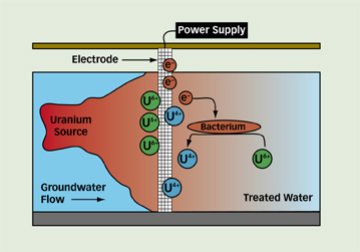- More than 2 years ago
Inspired by recent successes at using microbes in fuel cells to produce energy, researchers have devised a bioremediation system that electrically stimulates bacteria to break down toxic chemicals in the environment.

In a microbial fuel cell, bacteria stick to the surface of an electrode. As the bacteria metabolize organic matter in either sediment (SN: 7/13/02, p. 21: Available to subscribers at Voltage from the Bottom of the Sea: Ooze-dwelling microbes can power electronics) or wastewater (SN: 3/13/04, p. 165: Special Treatment: Fuel cell draws energy from waste), the microorganisms transfer electrons to the electrode, producing a current.
Researchers at the University of Massachusetts-Amherst, led by Derek Lovley, wondered whether reversing this process could work for cleaning up nuclear waste sites and other polluted venues that lack the organic matter that bacteria need for bioremediation jobs. The researchers proposed a system in which an electrode, instead of receiving electrons, would donate them to the microbes.
“The idea of trying to drive electrons into bacteria and use [them] for remediation is a very interesting one,” says environmental engineer Bruce Logan of Pennsylvania State University in State College.
The Massachusetts group tested its idea in the lab using sediments from a uranium-contaminated aquifer in Rifle, Colo., a sandy environment with little or no organic material. The researchers inserted a graphite electrode into the sample, charged it up, and observed the responses of the sediment’s naturally occurring bacteria. The microbes quickly began to add electrons to the uranium, converting it into a less mobile and therefore less troublesome form.
What’s more, because the electrode is negatively charged and the uranium in the sediment exists in the form of highly charged positive ions, the ions migrate toward the graphite electrode and then stick to it.
In previous experiments, the Massachusetts team stimulated the uranium-converting bacteria at the Rifle site by injecting acetate, which the microbes could metabolize, into the groundwater. As a result, the bacteria dumped electrons onto the uranium ions in the sediment, converting them into a form that sticks to the sediment. This keeps the uranium in place, preventing it from, for example, spreading and contaminating drinking wells downstream.
“The beauty of the electrode system is that it allows us to extract uranium from the subsurface rather than simply immobilizing it,” says team member Kelvin Gregory who presented his group’s findings on Aug. 26 in Philadelphia at the national meeting of the American Chemical Society. Because the electrodes are removable, the system allows for the actual extraction of uranium from the contaminated sediment and groundwater.
Current uranium-remediation strategies involve excavating and hauling away contaminated soil or pumping millions of liters of groundwater into aboveground treatment facilities. “These strategies are prohibitively expensive,” says Gregory. Sinking arrays of removable electrodes into the ground could be a more cost-effective approach, he adds. The Massachusetts team plans to test its scheme in the field next year.





